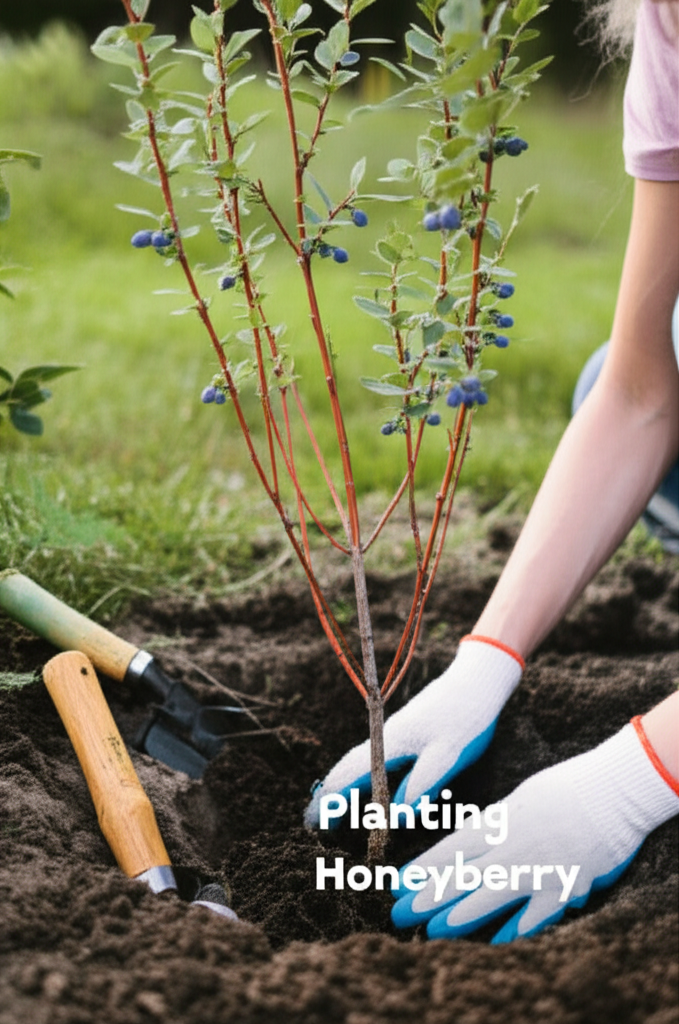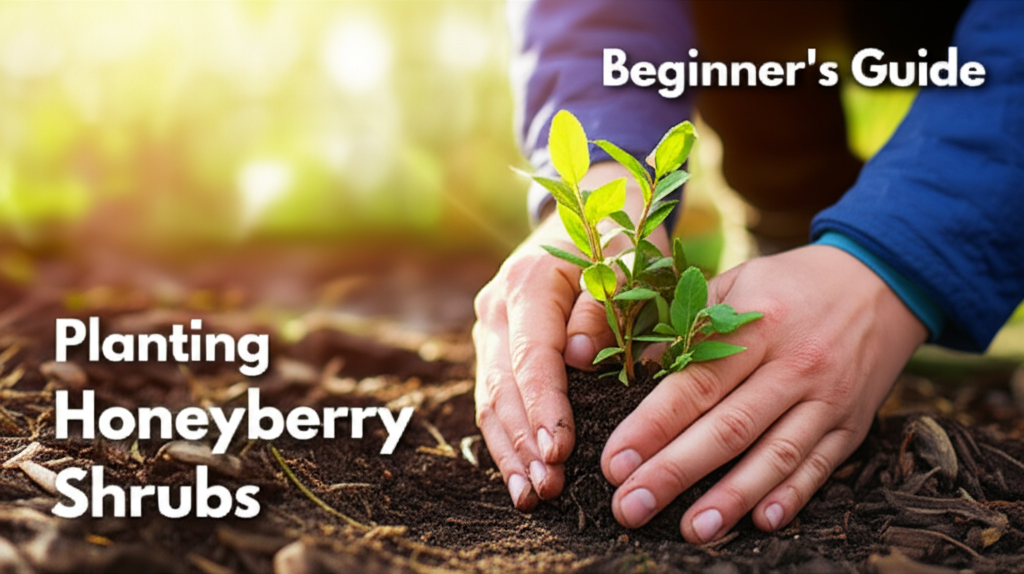Welcome to the Sweet World of Honeyberries
Honeyberries, also known as Haskap or Lonicera caerulea, are a fascinating and increasingly popular addition to home gardens. These hardy, cold-tolerant shrubs offer a unique, tart-sweet berry reminiscent of a blueberry with a hint of raspberry, ready for harvest much earlier than most other berry crops. Perfect for beginners, honeyberries are low-maintenance once established and can thrive in a variety of climates. This comprehensive guide will walk you through every step of planting your own honeyberry bushes, ensuring a successful and delicious harvest for years to come.
Understanding Honeyberry Bushes

Before we dive into planting, let’s get acquainted with these remarkable plants. Honeyberry bushes are native to the northern hemisphere, found in regions stretching across North America, Europe, and Asia. Their resilience is a key factor in their growing appeal.
Key Characteristics of Honeyberry Plants
- Hardiness: Honeyberries are exceptionally cold-hardy, often surviving temperatures as low as -40°F (-40°C). They are also remarkably heat-tolerant once established.
- Early Blooming & Fruiting: They are among the earliest fruit-bearing plants, often blooming in early spring and producing fruit in late May or June, sometimes even before strawberries are ready.
- Pollination: Most honeyberry varieties require cross-pollination from a different variety to produce a good crop. Planting at least two different, compatible varieties is crucial.
- Growth Habit: Honeyberry bushes typically grow to be 4-6 feet tall and wide, forming an upright, bushy habit.
- Berry Flavor: The berries are oblong, about ½ to 1 inch long, with a unique sweet-tart flavor. They are packed with antioxidants and vitamins.
Planning Your Honeyberry Planting
Successful planting begins with careful planning. Consider these essential factors before you even purchase your plants.
Choosing the Right Location
The site you choose for your honeyberry bushes will significantly impact their growth and yield.
- Sunlight: Honeyberries prefer full sun to partial shade. While they can tolerate some shade, at least 6-8 hours of direct sunlight per day will result in the best fruit production.
- Soil Drainage: Excellent drainage is paramount. Honeyberries will not tolerate waterlogged soil, which can lead to root rot. If your soil is heavy clay, consider amending it with organic matter or planting in raised beds.
- Soil pH: Honeyberries generally prefer slightly acidic soil with a pH range of 5.5 to 7.0. Testing your soil’s pH can help you determine if amendments are needed.
- Wind Protection: While hardy, young plants can benefit from some protection from strong winds, especially in exposed locations. Planting them near a fence or other established shrubs can provide this.
- Space: Allow adequate space for the mature size of the bushes. Plan for at least 4-6 feet between plants and 5-7 feet from other structures or larger plants.
Selecting Honeyberry Varieties
The key to a successful honeyberry harvest is choosing compatible varieties for cross-pollination. It’s also wise to select varieties known for good flavor and disease resistance.
Recommended Honeyberry Varieties for Beginners
Here are a few popular and reliable varieties that tend to do well for new growers:
- ‘Aurora’: A Canadian variety known for its large, sweet-tart berries and upright growth.
- ‘Borealis’: Another Canadian cultivar, offering large, juicy berries and good disease resistance.
- ‘Honeybee’: Produces firm, flavorful berries and is a good pollinator for other varieties.
- ‘Tundra’: Known for its early ripening and vigorous growth, with slightly firmer berries.
- ‘Indigo Gem’: A more compact variety with sweet, juicy berries.
Pollination Partners
When selecting varieties, ensure they bloom around the same time. Most Canadian and Russian varieties are good pollinators for each other. It’s a good practice to buy plants from reputable nurseries that specify their pollination compatibility.
When to Plant Honeyberries
The ideal time to plant honeyberry bushes is during the dormant season.
- Spring Planting: This is generally the best time, as soon as the ground can be worked in early spring, before new growth begins. This allows the roots to establish before the heat of summer.
- Fall Planting: Fall planting is also a viable option in milder climates. Plant at least 4-6 weeks before the ground freezes to allow roots to establish.
Preparing for Planting
Proper preparation of both the site and your plants will set the stage for healthy growth.
Soil Preparation
Improving your soil is crucial for honeyberry success.
- Amendments: Incorporate generous amounts of compost or well-rotted manure into the planting area. This improves soil structure, drainage, and fertility.
- pH Adjustment: If your soil is too alkaline, you can add elemental sulfur in the fall to lower the pH gradually. If it’s too acidic, lime can be added, but do so well in advance of planting.
- Raised Beds: For areas with heavy clay or poor drainage, consider building raised beds filled with a quality soil mix.
Preparing Your Honeyberry Plants
Whether you receive bare-root plants or container-grown ones, they need a little attention before going into the ground.
- Bare-Root Plants:
Soak the roots in a bucket of water for a few hours (but no more than 6-8 hours) before planting.
Trim any broken or damaged roots.
- Container-Grown Plants:
Water the plant thoroughly before removing it from the pot.
Gently loosen any circling roots by scoring the root ball with a sharp knife or fork.
Planting Your Honeyberry Bushes
Now for the main event – getting your honeyberry bushes into the ground!
Step-by-Step Planting Guide
Follow these steps for optimal planting.
- Dig the Planting Hole: Dig a hole that is at least twice as wide and as deep as the root ball of your honeyberry plant. This allows the roots to spread easily.
- Amend the Soil: Mix about one-third compost or well-rotted manure with two-thirds of the excavated soil.
-
Position the Plant:
- For bare-root plants, create a cone of soil in the center of the hole and spread the roots over it. Ensure the graft union (if present) or the root collar is at or slightly above soil level.
- For container-grown plants, place the plant in the hole so that the top of the root ball is level with the surrounding soil.
- Backfill the Hole: Gently backfill the hole with the amended soil, lightly tamping it down to remove air pockets. Avoid compacting the soil too much.
- Water Thoroughly: Water the newly planted bush deeply to settle the soil around the roots and eliminate any remaining air pockets.
- Mulch: Apply a 2-3 inch layer of organic mulch (like wood chips, straw, or shredded bark) around the base of the plant, keeping it a few inches away from the trunk to prevent rot. Mulch helps retain moisture, suppress weeds, and regulate soil temperature.
Spacing Your Plants
Proper spacing is essential for air circulation, sunlight penetration, and ease of harvesting.
- Plant honeyberry bushes 4-6 feet apart.
- Ensure adequate space between rows if planting multiple bushes, typically 8-10 feet.
Initial Care and Maintenance
Your honeyberry bushes are planted! Now, let’s ensure they get off to the best start.
Watering
- Initial Watering: Water deeply immediately after planting.
- First Year: Keep the soil consistently moist, especially during dry spells. Aim for about 1-2 inches of water per week, either from rain or irrigation.
- Established Plants: Once established, honeyberries are quite drought-tolerant. However, watering during prolonged dry periods will improve fruit size and quality.
Fertilizing
- First Year: Avoid heavy fertilization in the first year. Focus on good soil preparation.
- Established Plants: In subsequent years, you can fertilize in early spring with a balanced, slow-release fertilizer or a top dressing of compost. Avoid over-fertilizing, especially with nitrogen, as this can lead to excessive leafy growth at the expense of fruit.
Weeding
- Keep the area around your honeyberry bushes free of weeds, which compete for water and nutrients.
- The mulch you applied will help significantly with weed suppression.
Pruning
Honeyberries benefit from annual pruning to maintain shape, promote air circulation, and encourage fruit production.
- First Few Years: Focus on shaping the plant, removing any weak or crossing branches. Aim to develop a strong framework of 6-10 main stems.
- Mature Plants: Prune annually in late winter or early spring, before new growth begins. Remove dead, damaged, or crossing branches. Thin out older, less productive stems to encourage new growth from the base.
Troubleshooting Common Issues
While generally disease and pest-resistant, a few issues can arise.
Pests
Honeyberries are typically not plagued by many pests.
- Birds: Birds love ripe honeyberries! Netting your bushes as the fruit begins to ripen is the most effective way to protect your harvest.
- Aphids: Occasionally, aphids can infest new growth. A strong spray of water or insecticidal soap can usually manage them.
Diseases
Honeyberries are remarkably disease-resistant.
- Fungal Diseases: In very humid conditions or if planted too closely, some fungal issues like powdery mildew can occur. Good air circulation from proper spacing and pruning helps prevent this.
- Root Rot: This is the most serious issue and is caused by poor drainage. Ensure your planting site has excellent drainage.
Key Facts and Comparison
Let’s summarize the essential information for your honeyberry planting journey.
| Aspect | Details |
|---|---|
| Botanical Name | Lonicera caerulea |
| Common Names | Honeyberry, Haskap, Blue Honeysuckle |
| Sunlight Requirement | Full sun to partial shade (6+ hours sun ideal) |
| Soil pH | 5.5 – 7.0 (slightly acidic) |
| Soil Drainage | Excellent drainage required |
| Hardiness Zones | Generally Zones 2-7 (varies by variety) |
| Pollination | Requires cross-pollination from a different variety |
| Planting Time | Early spring (preferred) or fall |
| Mature Size | 4-6 feet tall and wide |
| Fruiting Time | Late May to June (early season) |
| Berry Flavor | Sweet-tart, similar to blueberry/raspberry |
Pros and Cons of Planting Honeyberries
Understanding the advantages and disadvantages can help you make an informed decision.
| Pros | Cons |
|---|---|
| Extremely cold-hardy (suitable for cold climates) | Requires at least two different varieties for pollination |
| Very low maintenance once established | Berries can be tart until fully ripe; some varieties are sweeter than others |
| Early season harvest (often before other berries) | Susceptible to root rot in poorly drained soil |
| High in antioxidants and vitamins | Birds are attracted to the ripening fruit |
| Tolerant of a variety of soil types (with good drainage) | Newer to commercial cultivation, so availability of specific varieties can vary |
| Resistant to most common fruit diseases and pests | Can be challenging to find compatible pollination partners locally sometimes |
Harvesting Your Honeyberries
The reward for your efforts! Honeyberries are typically ready to harvest in late May or June.
- Ripeness: Berries are ripe when they have a uniform deep blue color and are slightly soft to the touch. They should detach easily from the stem.
- Harvesting Technique: Gently pick the berries individually or cup your hand beneath a cluster and gently shake; ripe berries will fall into your hand.
- Usage: Honeyberries are versatile. They can be eaten fresh, used in pies, jams, jellies, smoothies, or juices.
Conclusion
Planting honeyberry bushes is a rewarding endeavor for any gardener, especially beginners. Their resilience, early harvest, and unique flavor make them a fantastic addition to any edible landscape. By following these guidelines on site selection, variety choice, planting techniques, and ongoing care, you’ll be well on your way to enjoying a delicious and abundant harvest of these nutritious berries. Happy planting!


